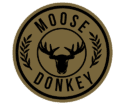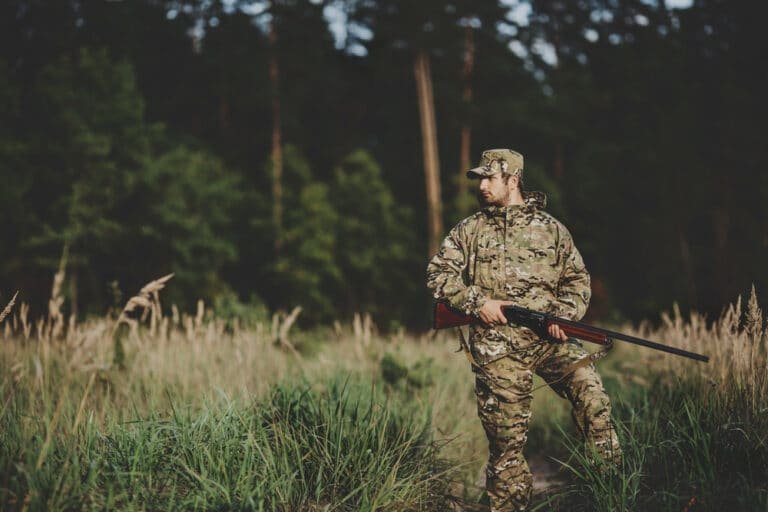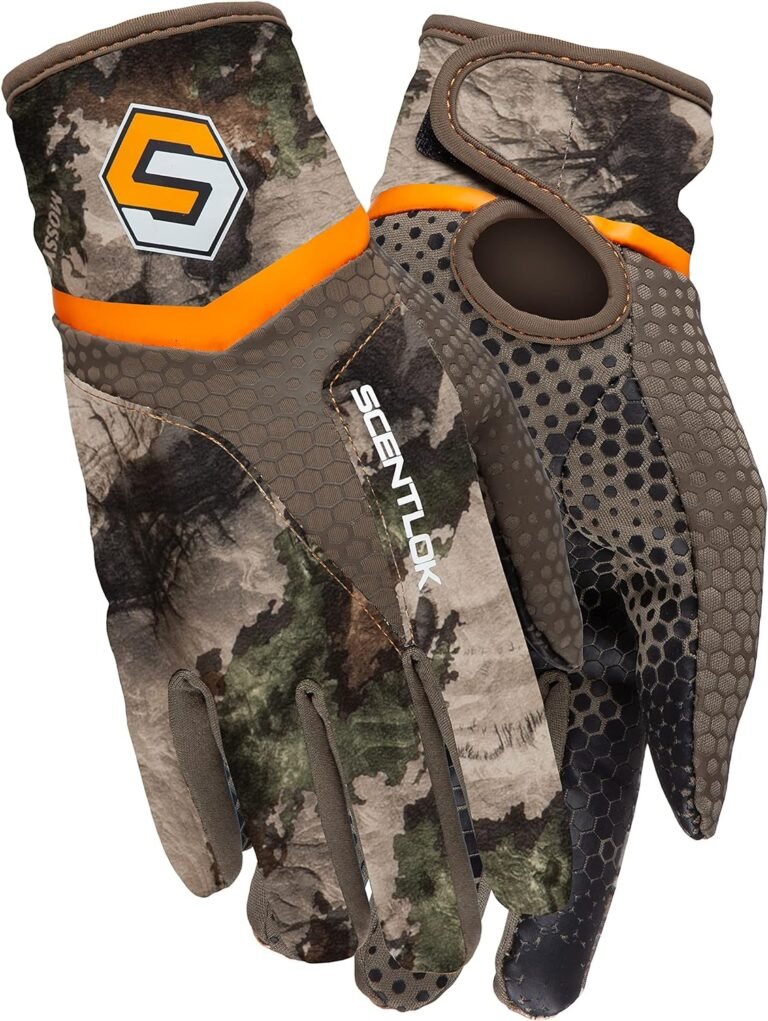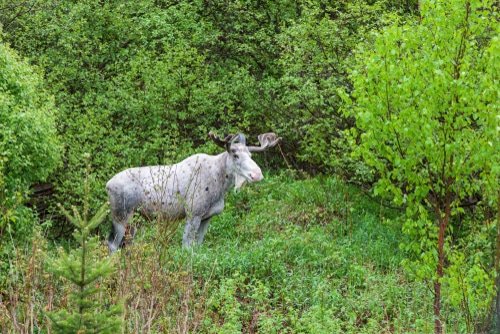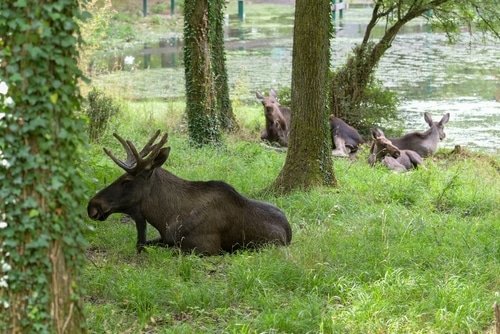Imagine tracking a massive bull moose through the misty wilderness, your heart pounding as you raise your rifle. In that crucial moment, will your chosen caliber have what it takes to bring down North America’s largest land animal ethically and effectively? Let’s review the best caliber for moose hunting and find out.
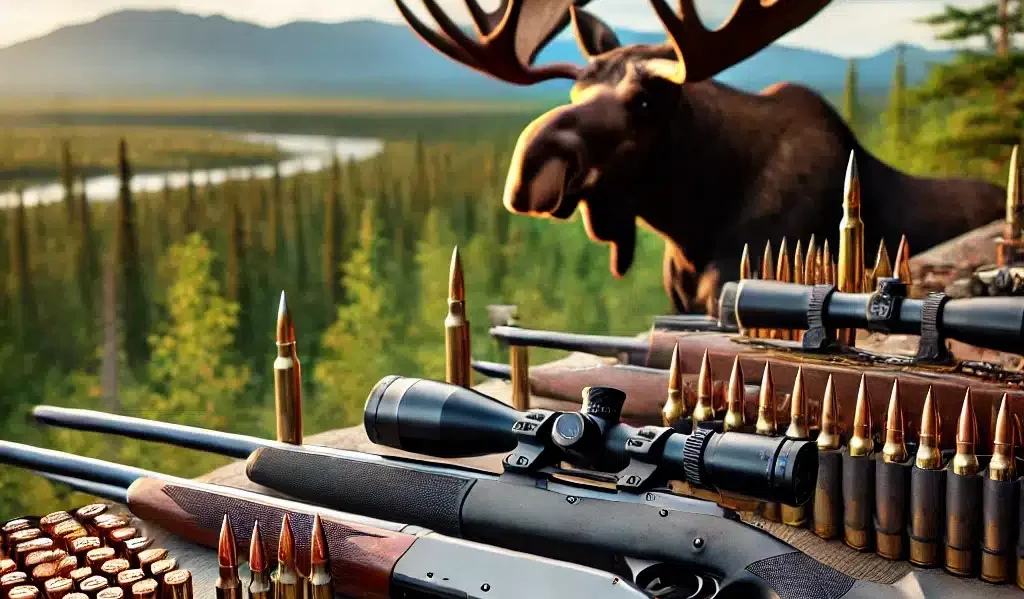
When it comes to moose hunting, the margin between success and disappointment often comes down to one critical decision: your choice of caliber. As formidable as they are majestic, moose demand a firearm and ammunition combination that can match their imposing size and legendary toughness.
But with a dizzying array of options, how do you determine the best caliber for moose hunting? Should you opt for the tried-and-true .30-06 Springfield or the hard-hitting .338 Winchester Magnum? What about those seeking a versatile round that takes both moose and bear?
This comprehensive guide will cut through the ballistic jargon and marketing hype to provide clear, practical advice on selecting the ideal moose hunting caliber. Drawing on the expertise of seasoned hunters and ballistics data, we’ll explore the top contenders for the title of best moose cartridge, delve into ammunition selection, and even touch on rifle considerations.
Whether you’re a veteran hunter looking to optimize your gear or a newcomer planning your first foray into moose country, this guide will equip you with the knowledge to make an informed decision. We’ll cover everything from the minimum caliber for ethical moose hunting to the best options for combination hunts involving elk or bear.
So grab your hunting jacket, settle in, and embark on a journey to find the perfect caliber for your next moose hunting adventure. By the end of this post, you’ll be well-armed – both with knowledge and the confidence to choose a caliber that will serve you well in the field.
Top Calibers for Moose Hunting
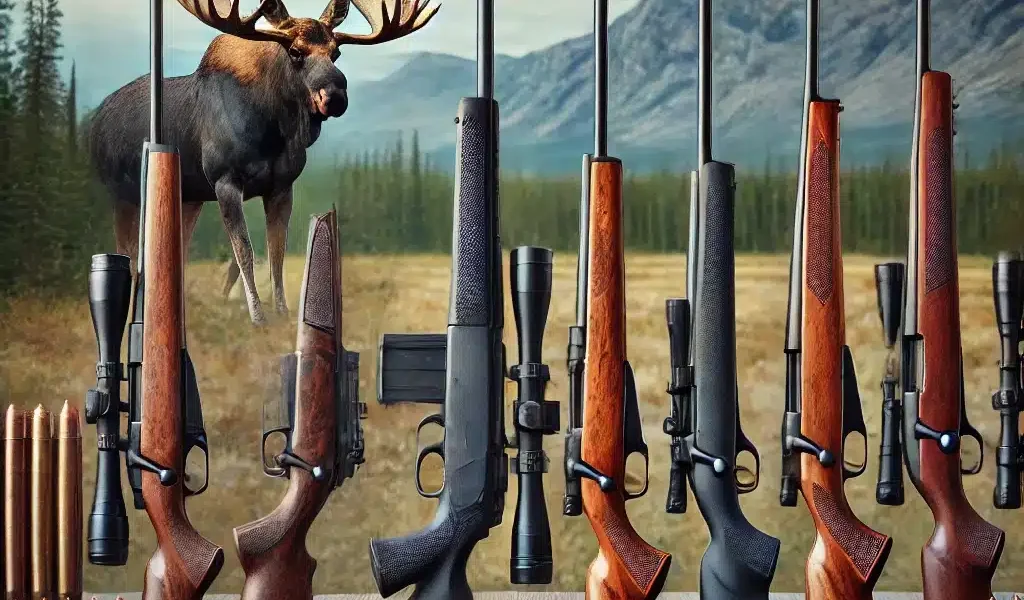
Several options have proven their worth over decades of use in the field when it comes to selecting the best caliber for moose hunting. Let’s examine five top contenders, each with its own strengths and considerations.
.30-06 Springfield

- Pros: Excellent balance of power and manageable recoil, widely available ammunition in various bullet weights, versatile for other big game, including elk
- Cons: May be considered borderline for larger moose at extended ranges
- Key Points: Ideal bullet weights for moose: 180-220 grains, effective range: Up to 300 yards for most hunters
.300 Winchester Magnum
The .300 Win Mag is a step up in power from the .30-06, offering increased velocity and energy.

- Pros: Superior long-range performance, excellent penetration and energy transfer, versatile for moose, elk, and bear
- Cons: Increased recoil compared to .30-06, more expensive ammunition
- Key Points: Ideal bullet weights for moose: 180-200 grains, effective range: Beyond 400 yards in capable hands
.338 Winchester Magnum
Often considered the gold standard for moose hunting, the .338 Win Mag offers tremendous power.

- Pros: Exceptional stopping power and penetration, ideal for larger moose and bear, flat trajectory for a large caliber
- Cons: Significant recoil may affect shot placement for some hunters, ammunition can be expensive and less readily available
- Key Points: Ideal bullet weights for moose: 200-250 grains, effective range: Up to 400 yards comfortably
7mm Remington Magnum
The 7mm Rem Mag offers a flatter trajectory and less recoil than larger magnum cartridges.

- Pros: Excellent balance of power, range, and manageable recoil; flat trajectory aids in long-range accuracy, versatile for various big game species
- Cons: Some consider it light for the largest moose may not be ideal for moose and bear combination hunts
- Key Points: Ideal bullet weights for moose: 160-175 grains, effective range: Beyond 400 yards with proper loads
.308 Winchester
While often overlooked for moose, the .308 Winchester can be effective in the right hands.

- Pros: Mild recoil allows for quick follow-up shots, widely available and affordable ammunition, excellent accuracy potential
- Cons: Less powerful than magnum options, may be considered light for larger moose.
- Key Points: Ideal bullet weights for moose: 165-180 grains, effective range: Up to 250 yards for ethical moose hunting
Each caliber can be effective for moose hunting when matched with proper ammunition and used within its limitations. The best caliber for you will depend on various factors, including your shooting ability, hunting conditions, and personal preferences.
Factors to Consider When Choosing a Caliber
Selecting the best caliber for moose hunting involves more than picking the most powerful option. Several factors come into play:
Recoil Management
- Importance of recoil control:
- It affects shot placement accuracy
- Influences follow-up shot speed
- Can impact hunter’s confidence and shooting comfort
- Recoil considerations:
- Larger calibers generally produce more recoil
- Rifle weight and design can mitigate recoil
- Personal tolerance varies among hunters
Tip: If you’re sensitive to recoil, consider a caliber like the .30-06 or 7mm Rem Mag over larger options like the .338 Win Mag.
Ammunition Availability and Cost
- Availability factors:
- More common calibers (e.g., .30-06, .308) are widely available
- Specialty rounds may be harder to find, especially in remote areas
- Cost considerations:
- Magnum calibers typically cost more per round
- Practice ammunition can be a significant expense
- Consider the long-term costs of your chosen caliber
Tip: Choose a caliber with readily available ammunition if you plan to hunt in remote areas.
Versatility for Other Game
- Multi-species hunting:
- Some hunters prefer a single rifle for multiple game animals
- Consider calibers effective for both moose and elk or bear
- Versatile options:
- .30-06 Springfield: Good for moose, elk, and deer
- .300 Win Mag: Excellent for moose, elk, and bear
- 7mm Rem Mag: Versatile for various big game species
Tip: If you’re looking for the best caliber for elk and moose or the best for moose and bear, consider a versatile option like the .300 Win Mag.
Personal Shooting Skills and Comfort
- Shooting proficiency:
- More powerful calibers require greater skill to shoot accurately
- Consider your experience level and shooting frequency
- Physical factors:
- Body size and strength can influence caliber choice
- Health issues (e.g., shoulder problems) may limit options
- Shooting distances:
- Assess your typical hunting scenarios and maximum comfortable shooting distance
- Longer-range hunting may benefit from flatter-shooting calibers
Tip: Be honest about your shooting abilities. It’s better to choose a caliber you can shoot well than one overpowered for your skill level.
Legal and Ethical Considerations
- Local regulations:
- Some jurisdictions have minimum caliber requirements for moose hunting
- Check your local hunting regulations before making a decision
- Ethical considerations:
- Choose a caliber that ensures clean, ethical kills
- Consider the potential for wounded animals and difficult tracking situations
Tip: While larger calibers offer more room for error, shot placement is still crucial. Choose a caliber that allows you to place accurate shots consistently.
By carefully considering these factors, you can narrow your options and choose the best caliber for your specific moose hunting needs. Remember, the “best” caliber is the one you can shoot accurately and confidently under hunting conditions.
Ammunition Selection
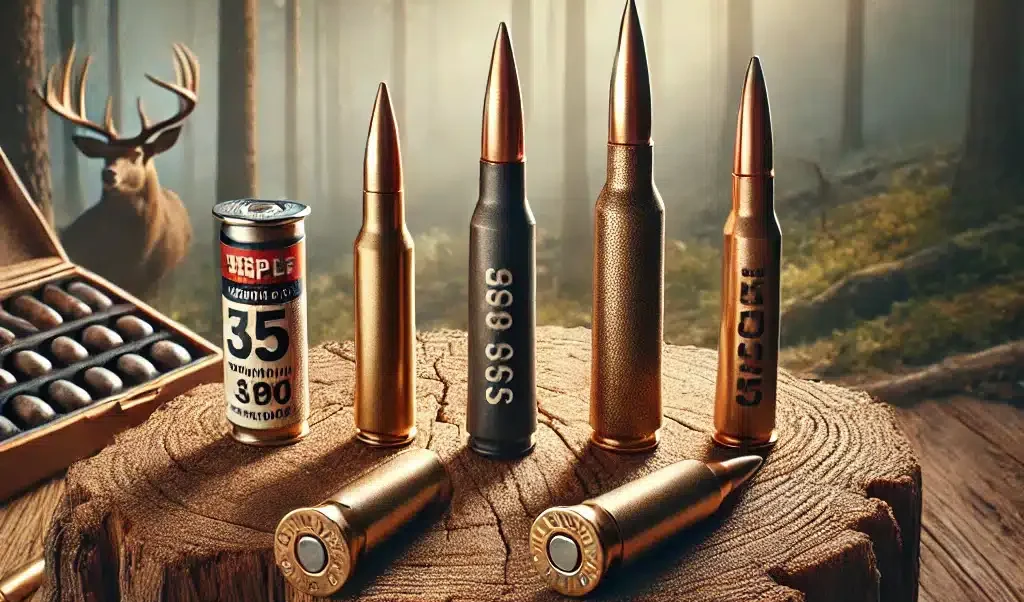
Choosing the right ammunition is just as crucial as selecting the proper caliber for moose hunting. Let’s explore the key considerations for ammunition selection:
Bullet Weight Considerations
- Importance of bullet weight:
- Affects velocity, energy, and penetration
- Influences trajectory and wind drift
- General guidelines:
- For moose, heavier bullets within a given caliber are often preferred
- Typical weight ranges:
- .30 caliber: 180-220 grains
- 7mm: 160-175 grains
- .338 caliber: 200-250 grains
Tip: Heavier bullets generally offer better penetration, which is crucial for large game like moose.
Bullet Construction
- Types of bullet construction:
- Bonded: Core and jacket are fused for controlled expansion and weight retention
- Partition: Separate front and rear cores for expansion and penetration
- Monolithic: Single-piece copper or copper alloy for deep penetration and minimal fragmentation
- Considerations for moose hunting:
- Controlled expansion is crucial for penetration through thick hide and muscle
- Weight retention ensures deep penetration into vital organs
Tip: Premium, controlled-expansion bullets are worth the extra cost for moose hunting.
Popular Ammunition Brands for Moose Hunting
- Federal Premium:
- Trophy Bonded Tip
- Trophy Copper
- Hornady:
- Precision Hunter ELD-X
- Outfitter GMX
- Nosler:
- AccuBond
- Partition
- Barnes:
- VOR-TX TTSX
- LRX
- Swift:
- A-Frame
- Scirocco II
Tip: While these brands are known for quality, always test multiple loads to find what shoots most accurately in your rifle.
Ballistic Performance
- Key ballistic factors:
- Muzzle velocity
- Energy retention
- Trajectory (bullet drop)
- Considerations for moose hunting:
- Aim for at least 1,500 ft-lbs of energy at your maximum expected shooting distance
- Consider bullet drop for longer-range shots
Tip: Use ballistic calculators or apps to compare loads and understand their performance at various distances.
Shot Placement and Penetration
- Importance of penetration:
- Moose have thick hides and dense muscle
- Vital organs are protected by heavy bone structure
- Ideal shot placement:
- Broadside: Behind the shoulder, targeting the heart and lungs
- Quartering: Angle towards opposite shoulder for maximum vital organ penetration
Tip: Choose ammunition that can reliably penetrate vital organs from various angles.
Practice and Familiarity
- Importance of practice:
- Familiarize yourself with recoil and trajectory
- Ensure consistent accuracy with your chosen ammunition
- Practice tips:
- Use similar weight practice ammunition to save cost
- Confirm zero with your actual hunting ammunition before the season
Tip: Practice at various distances and shooting positions to prepare for real hunting scenarios.
By carefully considering these factors in ammunition selection, you’ll be well-prepared to maximize your chosen caliber. Remember, the best caliber for moose hunting is only as effective as the ammunition you pair it with and your ability to place shots accurately.
Rifles for Moose Hunting
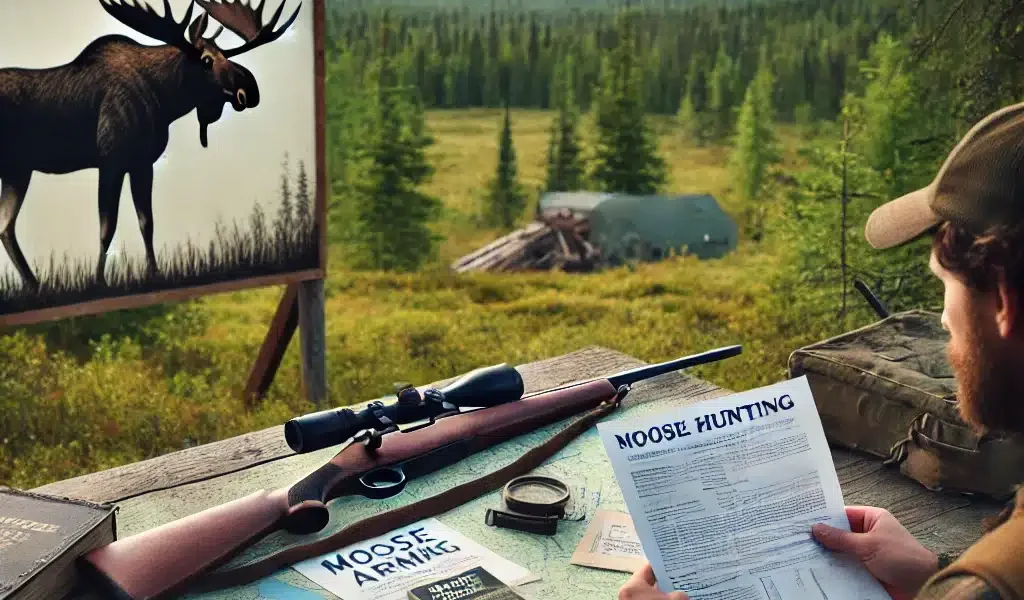
Choosing the right rifle to complement your caliber is crucial for a successful moose hunt. Let’s explore the key considerations for selecting a moose hunting rifle:
Action Types
- Bolt-action:
- Pros: Accuracy, reliability, and strength to handle magnum calibers
- Cons: Slower follow-up shots
- Semi-automatic:
- Pros: Faster follow-up shots, reduced felt recoil
- Cons: Generally heavier, may be restricted in some hunting areas
- Lever-action:
- Pros: Quick handling, traditional appeal
- Cons: Limited in terms of caliber options for moose
Tip: Bolt-action rifles are the most popular choice for moose hunting due to their reliability and ability to handle powerful calibers.
Rifle Weight and Length
- Weight considerations:
- Heavier rifles help manage recoil
- Lighter rifles are easier to carry in rugged terrain
- Length factors:
- Longer barrels generally offer better velocity
- Shorter barrels are more maneuverable in dense brush
Tip: Aim for a balance between carry comfort and shooting stability. A rifle around 7-8 pounds is often a good compromise.
Stock Materials and Design
- Wood stocks:
- Traditional appearance
- Can be affected by moisture and temperature changes
- Synthetic stocks:
- Durable and weather-resistant
- Often lighter than wood
- Stock design:
- Monte Carlo or raised comb for proper cheek weld with scoped rifles
- Recoil pad to help manage powerful calibers
Tip: A synthetic stock offers practical advantages for harsh weather conditions often encountered in moose country.
Barrel Considerations
- Length:
- 22-24 inches is typical for most moose hunting calibers
- Longer barrels can increase velocity but may be unwieldy
- Fluted vs. non-fluted:
- Fluting can reduce weight without sacrificing rigidity
- Primarily an aesthetic choice for most hunters
Tip: Unless you’re dealing with extreme conditions or preferences, standard barrel configurations work well for most moose hunting situations.
Optics and Sighting Systems
- Scope magnification:
- 3-9x or 2.5-10x variables are versatile choices
- Higher magnifications can be beneficial for longer shots
- Scope durability:
- Choose scopes designed to handle heavy recoil
- Look for weather-resistant features
- Backup iron sights:
- It can be useful in close encounters or if the scope fails
Tip: Invest in high-quality optics. They’re crucial for accurate shot placement, especially in low-light conditions common in moose hunting.
Popular Rifle Models for Moose Hunting
- Remington Model 700:
- Available in various calibers suitable for moose
- Known for accuracy and reliability
- Winchester Model 70:
- Classic design with modern improvements
- Offered in popular moose hunting calibers
- Ruger Hawkeye:
- Rugged construction
- Available in magnum calibers favored for moose
- Tikka T3x:
- Excellent out-of-the-box accuracy
- Smooth action and good value
- Weatherby Mark V:
- High-end option known for accuracy
- Can handle the most powerful moose cartridges
Tip: While these are popular choices, the best rifle for you is one that fits well and you can shoot accurately. Always try before you buy if possible.
Rifle Fit and Ergonomics
- Length of pull:
- Proper fit ensures consistent and comfortable shooting
- Especially important when wearing heavy hunting clothing
- Adjustability:
- Some stocks offer adjustable combs or length of pull
- Can be beneficial for achieving proper eye relief with scopes
Tip: A well-fitting rifle is crucial for accuracy. Consider professional fitting or adjustable features if standard rifles don’t suit your body type.
Remember, the best caliber for moose hunting is only as effective as the rifle it’s chambered in and the hunter behind it. Choose a rifle that complements your chosen caliber, fits you well, and inspires confidence in the field.
Calibers for Combination Hunts
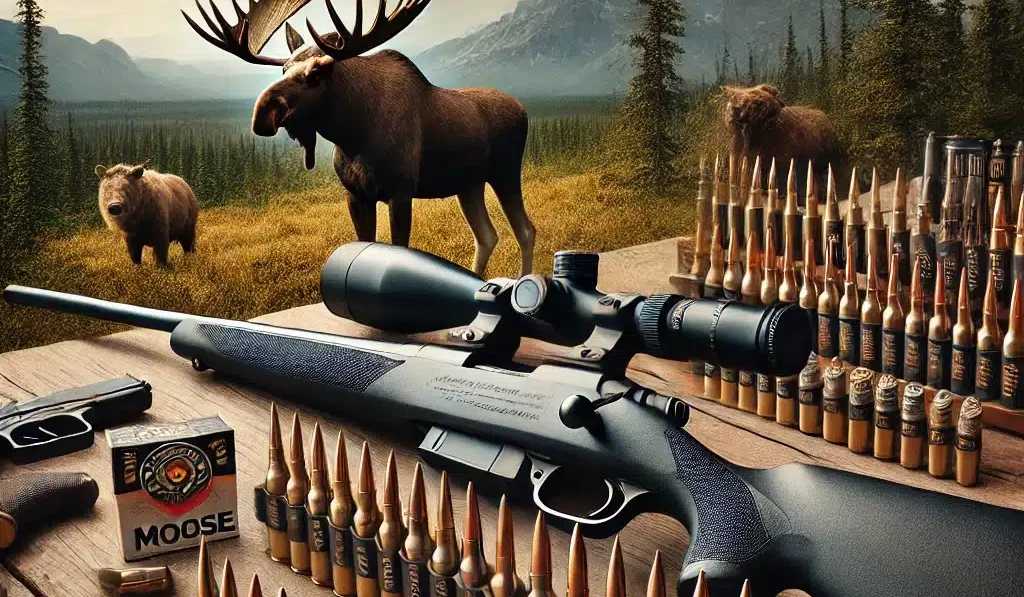
Many hunters seek versatile calibers that can effectively handle multiple big game species. Let’s explore some options for combination hunts involving moose and other large game:
Best Caliber for Elk and Moose
When considering a caliber suitable for both elk and moose, you’ll want a cartridge that offers enough power for the larger moose while not being overly powerful for elk.
- .300 Winchester Magnum:
- Pros: Excellent balance of power and range for both species
- Cons: Recoil may be stout for some shooters
- 7mm Remington Magnum:
- Pros: Flatter trajectory, less recoil than .300 Win Mag
- Cons: May be considered light by some for the largest moose
- .30-06 Springfield:
- Pros: Versatile, widely available ammunition
- Cons: May be borderline for largest moose at extended ranges
Tip: The .300 Win Mag is often considered the best all-around caliber for elk and moose, offering ample power for both species.
Best Caliber for Moose and Bear
When hunting areas inhabited by moose and bear, you’ll want a caliber capable of deep penetration and substantial energy transfer.
- .338 Winchester Magnum:
- Pros: Excellent stopping power for both moose and bear
- Cons: Significant recoil, may be overkill for smaller game
- .375 H&H Magnum:
- Pros: Versatile for all North American game, including dangerous game
- Cons: Heavy recoil may be more than necessary for typical moose hunting
- .300 Winchester Magnum:
- Pros: Good balance of power and manageable recoil
- Cons: May be considered light by some for the largest bears
Tip: The .338 Win Mag is often regarded as the best caliber for moose and bear, offering the right balance of power and penetration for both species.
Considerations for Combination Hunts
- Shot placement:
- Vital zones differ between species
- Practice shooting at different types of targets
- Ammunition selection:
- Choose bullets that perform well on both species
- Premium, controlled-expansion bullets are often best
- Recoil management:
- More powerful calibers may affect accuracy on smaller game
- Consider a muzzle brake or recoil pad for magnum calibers
- Legal requirements:
- Ensure your chosen caliber meets regulations for all intended species
- Some areas have minimum caliber requirements for dangerous game
Versatile Calibers for Multiple Species
- .30-06 Springfield:
- Suitable for: Deer, elk, moose (with proper loads), black bear
- Pros: Widely available ammunition, manageable recoil
- .300 Winchester Magnum:
- Suitable for: Elk, moose, bear, and long-range deer hunting
- Pros: Excellent balance of power and trajectory
- .338 Winchester Magnum:
- Suitable for: Moose, brown/grizzly bear, elk, African plains game
- Pros: Ample power for the largest North American game
Tip: When choosing a versatile caliber, consider the largest game you’ll hunt and ensure your choice suits that species. It’s better to be slightly overpowered for smaller game than underpowered for larger animals.
Practice and Familiarity
- Importance of practice:
- Shoot your combination hunting rifle regularly
- Practice with various types of targets simulating different game
- Load development:
- Find a load that performs well for all intended species
- This may involve compromises in optimal performance for any single species
Remember, while finding the best caliber for combination hunts is important, shot placement remains the most critical factor. A well-placed shot from a slightly smaller caliber is far more effective than a poorly placed shot from a larger caliber.
Expert Tips and Recommendations

To round out our guide on the best caliber for moose hunting, let’s explore some valuable insights from experienced hunters and ballistics experts:
Quotes and Advice from Experienced Moose Hunters
- John Nosler, founder of Nosler, Inc.: “When it comes to moose, penetration is key. Choose a bullet that will hold together and drive deep, regardless of the angle.”
- Craig Boddington, renowned hunting author, and television host: “The .30 calibers, from .30-06 upwards, are excellent choices for moose. They offer a great balance of power, accuracy, and manageable recoil.”
- Ron Spomer, outdoor writer, and hunting expert: “Don’t get caught up in magnum mania. A .30-06 with the right bullet will cleanly take any moose with good shot placement.”
Ballistics and Performance Data
- Energy recommendations:
- A minimum of 1,500 ft-lbs of energy at impact is often cited for moose
- Example: .300 Win Mag with 180 gr bullet typically retains over 1,500 ft-lbs past 500 yards
- Sectional Density (SD) considerations:
- Higher SD correlates with better penetration
- For moose, look for bullets with SD of .260 or higher
- Example: 180 gr in .30 caliber = .271 SD
- Bullet expansion characteristics:
- Aim for 1.5 to 2 times the original diameter expansion
- Retain at least 60% of the original weight for deep penetration
Additional Expert Recommendations
- Practice at various distances:
- Know your maximum effective range
- Understand your bullet’s trajectory
- Use a rangefinder:
- Accurately judging distance is crucial for ethical shots
- Consider hunting conditions:
- A heavy brush might favor larger calibers
- Open terrain could allow for lighter, flatter-shooting options
- Prioritize shot placement:
- The best caliber won’t compensate for poor shot placement
- Regular practice is key to accuracy under hunting conditions
- Be prepared for follow-up shots:
- Choose a rifle and caliber combination that allows for quick, accurate follow-ups
- Practice rapid target reacquisition
Emerging Trends in Moose Hunting Calibers
- Rise of 6.5mm and 6.8mm calibers:
- Offering excellent accuracy and moderate recoil
- Examples: 6.5 PRC, 6.8 Western
- Straight-wall cartridges in some regions:
- Where allowed, options like .450 Bushmaster are gaining popularity
- Offer good short to medium-range performance
- Monolithic bullets:
- Growing preference for all-copper bullets
- Excellent weight retention and penetration
Final Thoughts from Experts
- Confidence is key:
- The best caliber is one you can shoot accurately and confidently
- Ethical considerations:
- Choose a caliber that ensures clean, quick kills
- Versatility vs. Specialization:
- Decide whether you need a moose-specific rifle or a more versatile option
Remember, while choosing the right caliber is important, it’s just one part of successful moose hunting. Proper planning, stalking skills, and shot placement are equally crucial.
Conclusion

As we wrap up our comprehensive guide on the best caliber for moose hunting, let’s recap the key points and offer some final thoughts to help you make an informed decision for your next moose-hunting adventure.
Recap of Key Points
- Top caliber choices:
- .30-06 Springfield: Versatile and widely available
- .300 Winchester Magnum: Excellent balance of power and range
- .338 Winchester Magnum: Ideal for larger moose and bear
- 7mm Remington Magnum: Flat trajectory with manageable recoil
- .308 Winchester: Effective with proper bullet selection
- Factors to consider:
- Recoil management
- Ammunition availability and cost
- Versatility for other game
- Personal shooting skills and comfort
- Legal and ethical considerations
- Ammunition selection:
- Bullet weight and construction are crucial
- Premium, controlled-expansion bullets are worth the investment
- Practice with your chosen hunting load
- Rifle considerations:
- Bolt-action rifles are most popular for their reliability
- Balance weight between carry comfort and recoil management
- Proper fit and high-quality optics are essential
- Combination hunts:
- .300 Win Mag excels for elk and moose
- .338 Win Mag is favored for moose and bear
- Versatile calibers allow for multi-species hunts.
Final Advice
- Prioritize shot placement: Remember, the best caliber for moose hunting is only as effective as your ability to place shots accurately. Regular practice is key to success in the field.
- Consider your hunting style: Choose a caliber that aligns with your typical hunting scenarios, whether dense forest stalking or long-range shots in open terrain.
- Balance power and shoot ability: While it’s important to have enough power for ethical kills, it’s paramount to choose a caliber you can shoot comfortably and accurately.
- Don’t overlook versatility: Unless you’re exclusively hunting moose, consider a caliber that can effectively handle other games you might encounter.
- Invest in quality: From your rifle and optics to your ammunition, investing in quality gear will pay dividends in the field.
- Seek hands-on experience: If possible, try different calibers before making your final decision. Many shooting ranges offer rental options.
- Continual learning: Stay informed about new developments in ammunition and firearms. The “best” caliber is always evolving with technology.
Encouragement for Your Moose Hunting Journey
Choosing the best caliber for moose hunting is important, but it’s just one part of the broader hunting experience. Successful moose hunting also requires woodsmanship, patience, and respect for the animal and the environment.
Whether you opt for the tried-and-true .30-06, the versatile .300 Win Mag, or another caliber we’ve discussed, your success will ultimately depend on preparation, practice, and ethical hunting practices.
As you head into moose country, carry with you the right caliber and a deep appreciation for the magnificent animal you’re pursuing and the wild places it inhabits. Happy hunting, and may your adventures be safe, ethical, and memorable.
